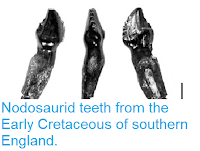Ankylosaurs were large, herbivorous Ornithischian Dinosaurs known from the Jurassic and Cretaceous. They are noted for their exceptional armour, with heads and bodies covered with thick plates of bone, their limbs by large spines which project from these plates, and their possession of weapons on their tails, either large bony clubs (Ankylosaurids) or large spines (Nodosaurids). This combination of large size, heavy armour and lethal-looking weaponry is surprising, as modern Mammals of comparable size to Ankylosaurs (basically Hippopotamus, Rhinoceros and Elephants) are largely ignored by even the largest predators, and Ankylosaurs lived alongside a range of smaller, less heavily armoured, and (presumably) generally more palatable Dinosaurs. This has led to the suggestion that the heavy armour and weaponry of Ankylosaurs may have been used in intra-specific competition (probably over mates) rather than to deter predators.
In a paper published in the journal Current Biology on 3 August 2017, Caleb Brown and Donald Henderson of the Royal Tyrrell Museum of Palaeontology, Jakob Vinther of the School of Biological Sciences and School of Earth Sciences at the University of Bristol, Ian Fletcher of the School of Mechanical and Systems Engineering at Newcastle University, and Ainara Sistiaga, Jorsua Herrera and Roger Summons of the Department of Earth, Atmospheric and Planetary Sciences at the Massachusetts Institute of Technology, describe a new and exceptionally well preserved Nodosaurid Ankylosaur from the Early Cretaceous Clearwater Formation of Alberta, Canada.
The specimen is described as a new species and named Borealopelta markmitchelli, where 'Borealopelta' means 'Northern Shield' and 'markmitchelli' honours Mark Mitchell, who spent more than 7000 hours preserving the specimen. This specimen is three dimensionally preserved and articulated, and comprises the head, most of the trunk, the right forelimb, most of the left forelimb, the hip joint, a foot, as well as much of the bony exoskeleton, including the soft tissue which covered it.
Borealopelta markmitchelli, (top) anterodorsolateral view, (bottom) anterodorsal view. Scale bar is 10 cm. Brown et al. (2017).
This specimen was preserved in soft mud in an inshore-marine environment. These rocks have previously produced Plesiosaurs and Ichthyosaurs, but this is the first known Dinosaur. The specimen shows no sign of scavenging (which is surprising as the sediments in which it was preserved were bioturbated). The specimen appears to have released body fluids explosively and subsequently collapsed shortly after burial.
Schematic Line Drawing of Borealopelta markmitchelli, Illustrating Preservation of the Different Tissue Types (A) Schematic of complete specimen in dorsal view. (B and C) Skull in dorsal (B) and left lateral (C) views. (D) Close-up view of the neck, illustrating alternating cervical osteoderm bands (and preserved keratinous sheaths) and polygonal scales. (E) Close up view of flank illustrating lateral thoracic osteoderms (with keratinous coverings) and polygonal scales. (F) Close-up view of sacral shield counterpart illustrating osteoderms and scales. (G) Close-up view of antebrachium including osteoderms and keratinous coverings. (D’–G’) Interpretive line drawings of the corresponding panels (D)–(G). Scale bars in (B)–(G), 10 cm. Brown et al. (2017).
A number of spectrographic analyses techniques were used on the organic material covering the exoskeleton of Borealopelta markmitchelli, which revealed the presence of (amongst other things) significant amounts of benzothiazole, a derivative of pheomelanin, a pigment molecule found in melanosomes (dark pigment cells), with a deep reddish-brown colour.
Ambient and UV fluorescent photographs of preserved spine sheaths. Photographs and line drawings of cervical osteoderm sheath in dorsal view (A-D), and right lateral view and left parascapular spine (E-H). (A) Dorsal view of osteoderm under visible light. (B) Inset in visible light showing parallel light coloured longitudinal striae and subtle darker bands. (C) Inset showing strong ultraviolet fluorescence of light striae. (D) Interpretative line drawing of (B). (E) Left lateral view posterior cervical and anterior thoracic regions in cross-polarised light. (F) Ultraviolet fluorescence showing same view as (E). (G) Inset showing ultraviolet fluorescence of parascapular spine. (H) Interpretative line drawing of (G) showing area of fluorescence. Brown et al. (2017).
This pigment is not evenly distributed, but rather suggests that the living Dinosaur was darker on its upper side and lighter below, a pattern called countershading, which provides camouflage to animals which have it. That an animal as large as Borealopelta markmitchelli (estimated to have had a mass of at least 1600 kg, similar in size to an Indian or White Rhinoceros) had camouflage is quite remarkable, as such patterns only appear when they provide an advantage which natural selection can favour, i.e. making the animal harder for a predator to spot or track. This suggests that evolutionary pressures were very different in the Mesozoic, with predators willing and able to hunt large, armoured, prey such as Ankylosaurs, which in turn supports the idea that the armour and weaponry was indeed used for defence against predators.
See also...
Follow Sciency Thoughts in Facebook.








